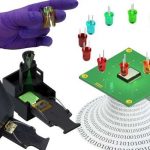 There are a growing number of mobile and wearable tools that are capable of diagnosing various conditions. Many of these tools look for proteins, biomarkers and the like to help spot the early onset of disease.
There are a growing number of mobile and wearable tools that are capable of diagnosing various conditions. Many of these tools look for proteins, biomarkers and the like to help spot the early onset of disease.
A recent study from researchers at UCLA highlights the cost effectiveness of using mobile devices and machine learning for this.
Plasmonic sensing
The project revolves around something known as plasmonic sensing, which is a method by which small objects, and their related biomarkers, can be detected. It uses light to amplify the local electric field, with the interaction between this and the target molecule then able to be measured, revealing information about the molecular concentration and kinetics.
It’s a technique that has been known about for decades, but the kind of equipment required to make it work render if impractical outside of a lab environment.
The team used machine learning to aid in the construction of a cheap, mobile device that is more accurate the existing sensor designs. The lightweight and portable device consists of four LEDs and a camera. The AI selects the right combination of LEDs, and also the appropriate method of quantifying the output from the sensors.
The device is used by applying a fluid, such as blood, to the sensor surface using a disposable microchip. The sensor is built into a cartridge, which can be inserted into the device and which automatically measures and analyzing the specimen.
It could eventually be developed as a smartphone add-on to drive down costs still further, whilst the team hope that their initial work will encourage other engineers and researchers to optimize their own low-cost optical sensor readers.
“Amazing discoveries and results are being made daily at research institutions like UCLA, but oftentimes when engineers begin to envision moving this science into the real world, they hit roadblocks,” the researchers say. “So it is always exciting to me to see cutting-edge technology become more practical.”